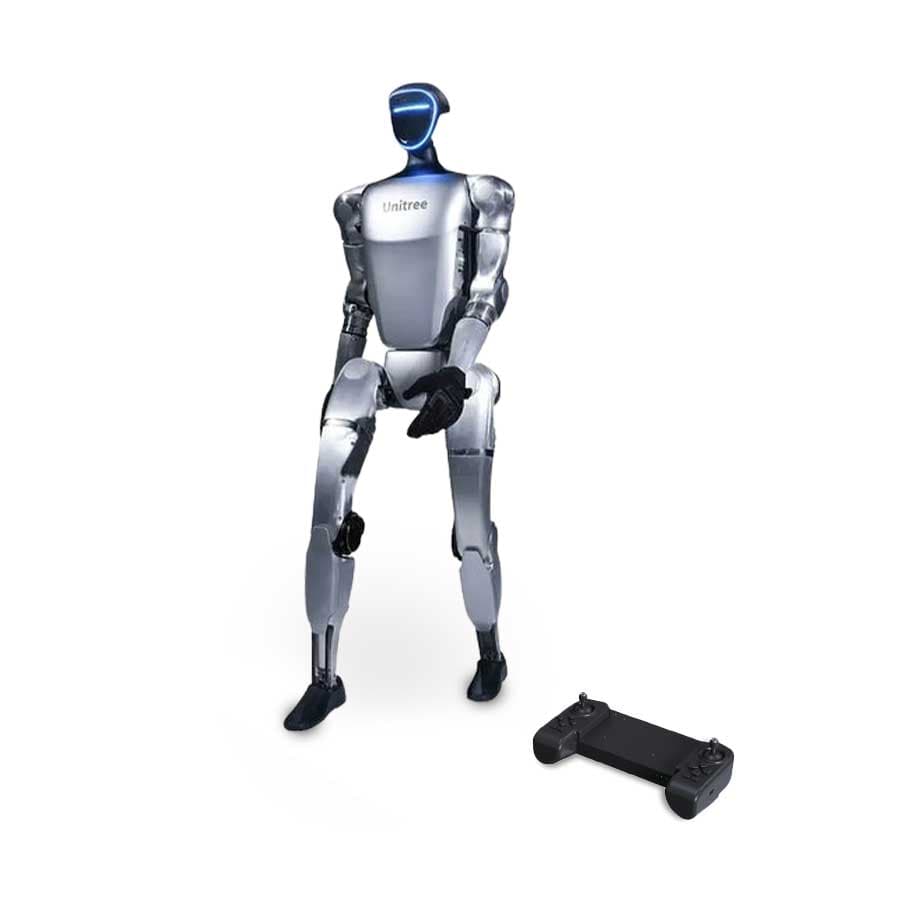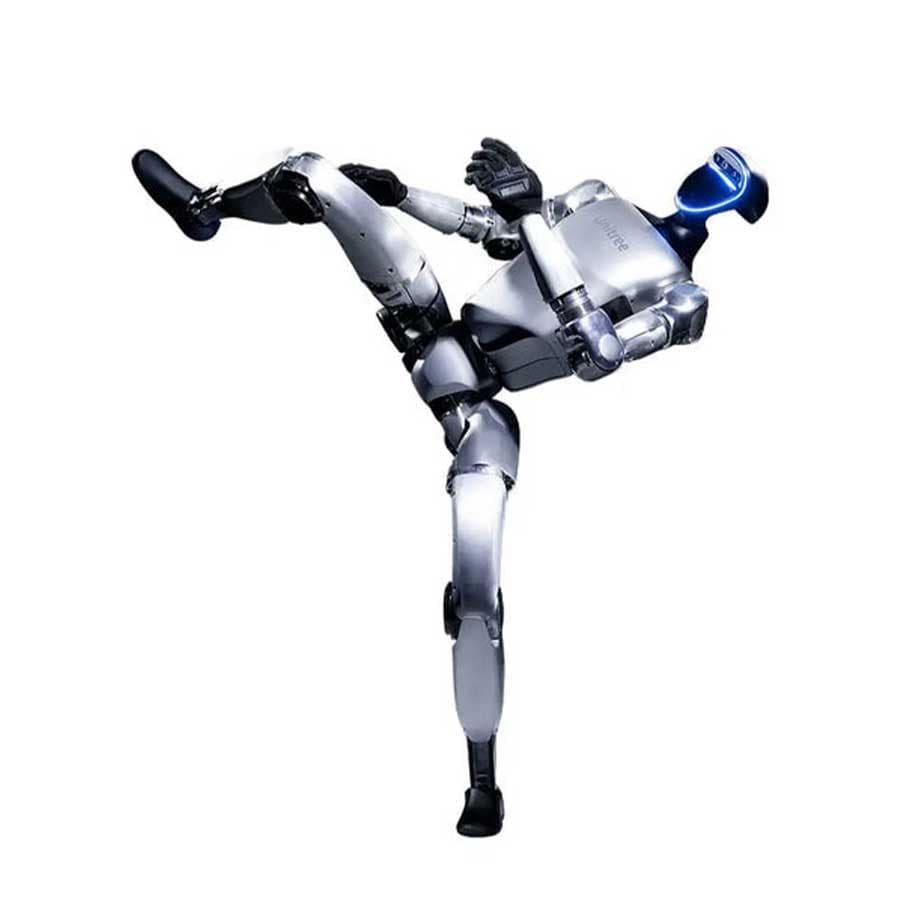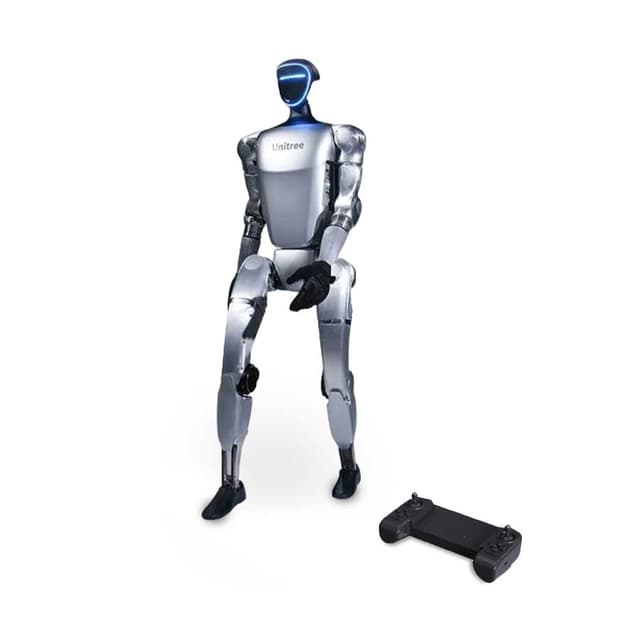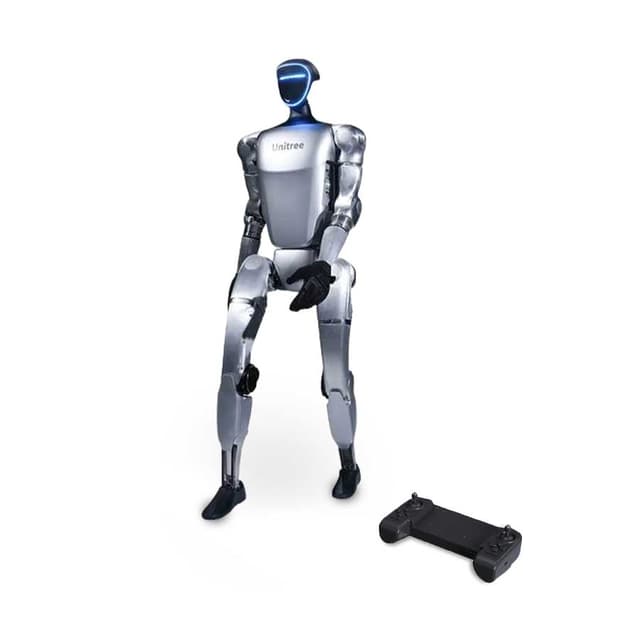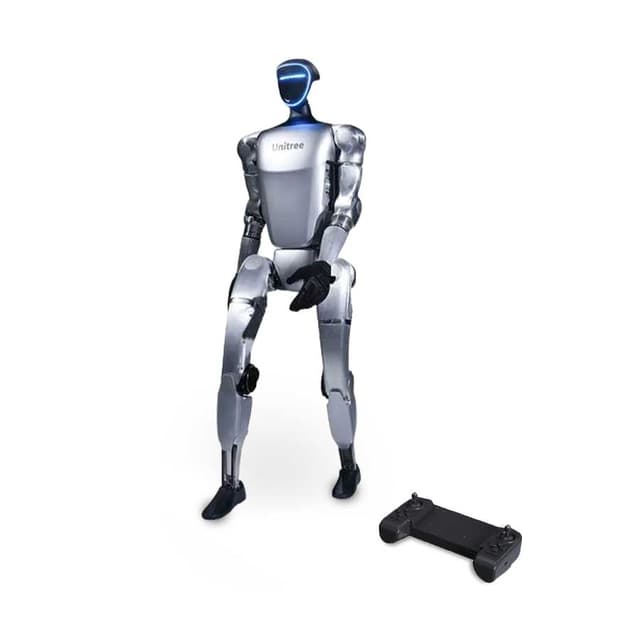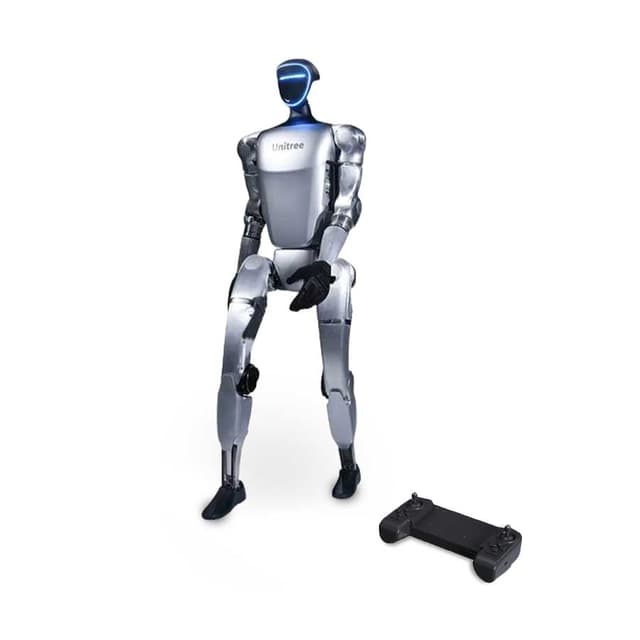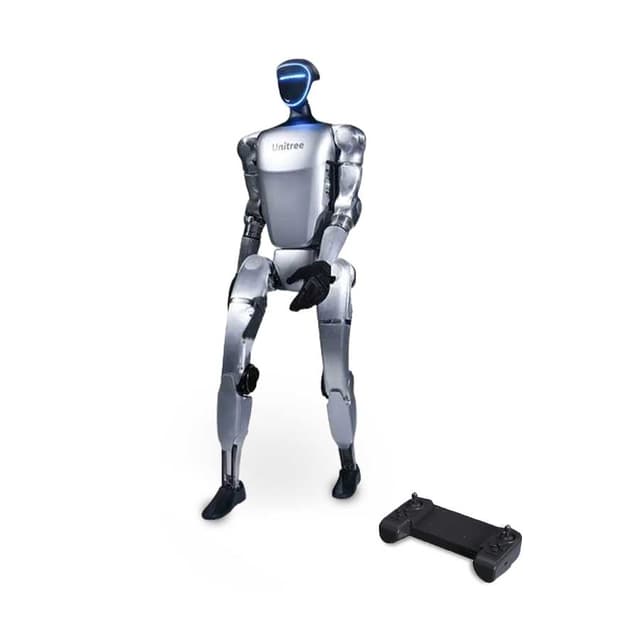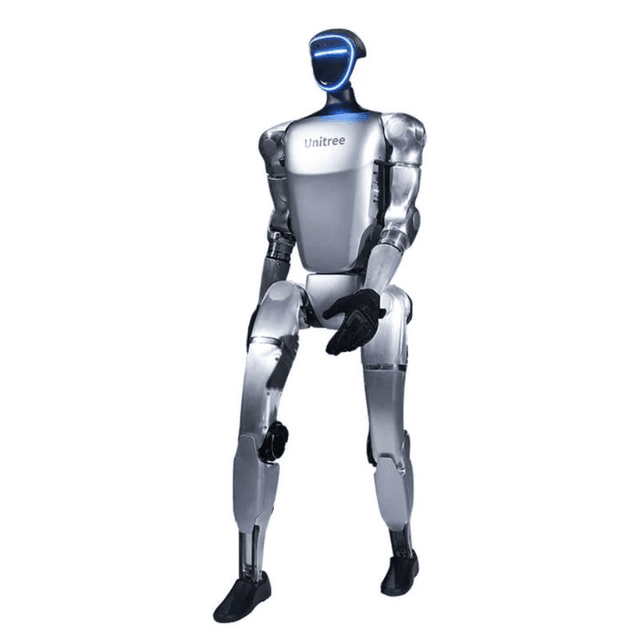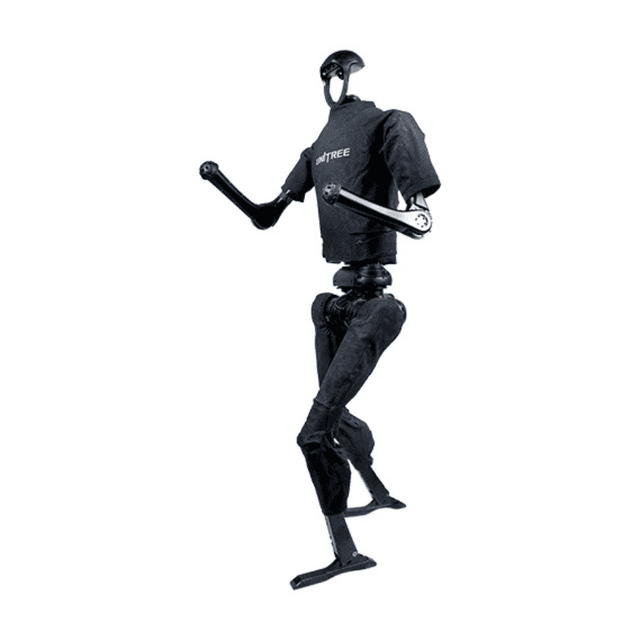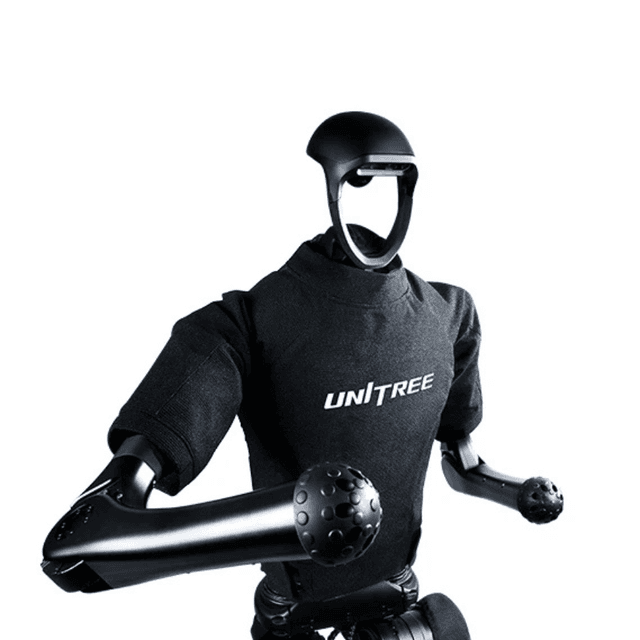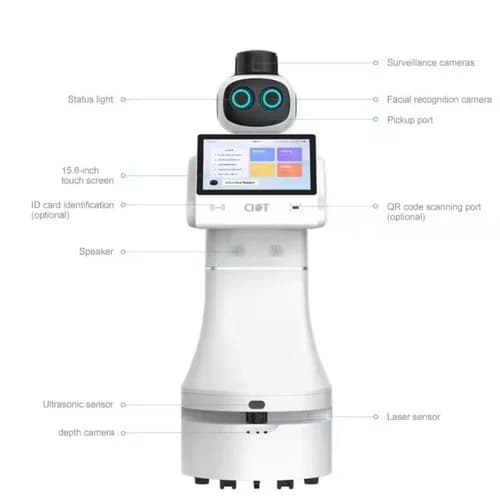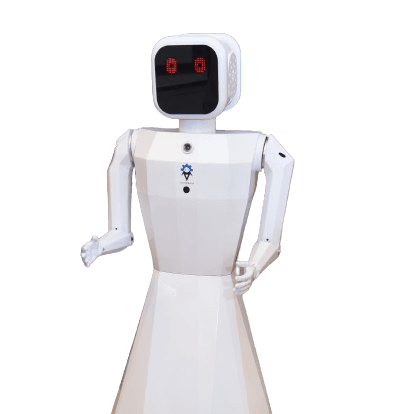Unitree G1 Edu-U5 Humanoid Robot – Available at Everse
Discover the Unitree G1 Edu-U5 Humanoid Robot, a cutting-edge robotic platform available through Everse. Engineered by Unitree, the G1 Edu-U5 combines advanced AI, exceptional mobility, and precise manipulation, making it an ideal choice for researchers, educators, and innovators across robotics, healthcare, and entertainment.
Human-Level Agility Through Advanced Joint Architecture
The Unitree G1 Edu-U5 humanoid robot stands out with its impressive physical agility, enabled by a sophisticated system of 23 to 43 joint motors and 41 degrees of freedom (DOF). Designed for lifelike human motion, this robot includes enhanced articulation in key areas, including 3 DOF in the waist and 7 DOF per arm. These expanded ranges of motion allow for precise, fluid movements, enabling the robot to walk, run, gesture, and balance with a degree of realism that mirrors human biomechanics. Each joint is engineered for both strength and fine control, making it possible for the robot to perform complex mobility tasks—such as dynamic postural shifts, crouching, turning, or reaching—while maintaining stability and coordination. The G1 Edu-U5’s construction uses a lightweight yet durable alloy and composite frame, which helps minimize inertia while supporting active locomotion across varied terrain. With an estimated weight of ~35 kg and a height of ~132 cm, it is scaled to human proportions, providing a naturalistic platform for real-world interaction studies and physical testing. The high torque capacity of the knee joints (up to 120N·m) enhances its ability to carry small payloads or maintain balance during advanced maneuvers, such as kneeling or shifting body weight mid-motion. Whether in a controlled lab or a simulated real-world environment, this agility enables a wide range of experimental and applied use cases, particularly in mobility research, cognitive robotics, and biomechanics.
Dexterous Manipulation with Five-Finger Robotic Hands
One of the most compelling aspects of the Unitree G1 Edu-U5 is its manipulation capability, delivered through two third-party five-finger robotic hands (models RH56DFQ-2R and RH56DFQ-2L). These hands feature precision engineering and utilize force-position hybrid control systems to replicate the tactile precision of the human hand. Designed for advanced dexterity, they allow the robot to perform delicate object handling, from gripping irregularly shaped items to performing coordinated hand movements for tasks like tool usage, typing, or interacting with touch-based interfaces. While traditional robots often rely on simplistic two-finger grippers, the Edu-U5’s five-finger hands provide nuanced motor control and contact feedback, making it capable of safely manipulating both fragile and resistant materials. Though specific tactile sensor counts are not detailed in this version, the control system ensures adaptive grip force and orientation, critical for handling dynamic or sensitive tasks. These capabilities are essential in fields like healthcare, where the robot may need to manage medical tools or assist in therapeutic exercises, and in education, where fine-motor demonstrations enhance training. The robot’s hand design also allows for bilateral coordination, enabling it to carry out two-handed operations that mirror human activity—such as opening containers, assembling parts, or performing gesture-based interaction. This enhanced manipulability supports extensive research in tactile robotics, robotic prosthetics development, and real-world collaboration between humans and machines. As a result, the G1 Edu-U5 offers a platform that advances the study of robotic dexterity far beyond basic grasping mechanics.
Intelligent Behavior with Integrated AI and Learning Models
The Unitree G1 Edu-U5 features a deeply integrated AI system powered by UnifoLM (Unitree Robot Unified Large Model), which supports both imitation and reinforcement learning. These learning strategies enable the robot to continuously evolve through experience, adapting its behavior to changing conditions and objectives. Imitation learning allows the G1 Edu-U5 to observe and replicate human actions, offering a powerful tool for behavior modeling, demonstration-based programming, and skill acquisition. This is particularly valuable in environments where intuitive interaction and natural behavior imitation are necessary, such as collaborative workspaces or training simulations. Reinforcement learning, on the other hand, helps the robot refine its performance through trial-and-error, enabling it to optimize actions based on feedback and rewards—ideal for dynamic problem-solving, obstacle navigation, or autonomous task execution. The robot’s onboard processing capabilities are further enhanced by a 100Tops computing unit embedded in an expansion dock, giving it real-time perception and decision-making capacity across multiple sensor inputs. These include voice commands, visual cues, and environmental data from depth cameras and sensor arrays. Natural language processing allows users to interact verbally with the robot, while integrated image recognition supports face and object detection for context-aware responses. Together, these systems make the G1 Edu-U5 an intelligent, multimodal platform that bridges the gap between mechanical automation and cognitive robotics. Whether in a research lab, classroom, or healthcare environment, this intelligence enables the robot to function not just as a tool, but as an adaptive, interactive partner.
Developer Ecosystem and Customization Support
Engineered for innovation, the Unitree G1 Edu-U5 is built with a highly accessible development framework that empowers users to create, modify, and deploy their own robotic solutions. It comes with an open SDK, comprehensive APIs, and detailed technical manuals, supporting both high- and low-level secondary development. This allows researchers, educators, and developers to customize nearly every aspect of the robot’s behavior—from low-level motor commands and joint trajectories to high-level AI decision-making and environmental interaction. The built-in 100Tops expansion dock serves as a versatile computing hub, enabling users to run resource-intensive applications like AI model inference, computer vision pipelines, or real-time data analytics directly on the robot. The platform supports integration with external hardware and sensors, and developers can implement custom scripts for gesture recognition, multi-modal control, or multi-robot collaboration. Additionally, the Edu-U5 is equipped with real-time data access from its onboard sensors, such as joint encoders, cameras, and interaction sensors, enabling detailed analysis and debugging. Its modular architecture ensures compatibility with a wide range of research and prototyping tools, including simulation environments and ROS-based systems. Whether you're building autonomous navigation routines, enhancing gesture-based control interfaces, or testing social robotics scenarios, the Unitree G1 Edu-U5 offers a flexible foundation tailored to advanced robotics development. Its openness and support documentation make it suitable for university courses, postgraduate research, and enterprise R&D teams looking to push the limits of humanoid robotics.
Practical Operation with Reliable Power and Connectivity
To meet the demands of real-world usage, the Unitree G1 Edu-U5 features a robust power and connectivity system optimized for performance and efficiency. The robot operates on a high-capacity rechargeable lithium-ion battery with an estimated runtime of 1 to 2 hours, depending on task complexity. This battery is supported by a fast-charging system that minimizes downtime and allows for frequent deployment throughout the day—ideal for classrooms, labs, or exhibitions. A local air-cooling mechanism ensures that internal temperatures remain stable even under sustained workloads, safeguarding system performance during intensive computing or full-body motion sequences. On the connectivity front, the Edu-U5 includes both Wi-Fi and Bluetooth, enabling seamless integration into local networks or device ecosystems. Whether communicating with external control stations, streaming data, or receiving remote updates, the robot maintains stable, high-speed connections essential for responsive operation and real-time interaction. Equipped with depth cameras and sensor arrays, it also supports spatial awareness and environment mapping—critical features for autonomous mobility, object avoidance, and user recognition. These integrated systems provide the stability and functionality necessary for deploying the robot in complex scenarios, from remote healthcare assistance to educational demonstrations and interactive performances. The hardware-software synergy ensures that the G1 Edu-U5 delivers a smooth and dependable experience across varied applications. Its self-contained, network-ready design means it can be easily transported, set up, and operated without the need for specialized infrastructure, reinforcing its position as a practical and powerful solution in next-generation humanoid robotics.
Key Features
- Superior Flexibility – Equipped with 23 to 43 joint motors and 41 degrees of freedom (DOF), including upgraded waist (3 DOF) and arm (7 DOF per arm) articulation, the G1 Edu-U5 delivers lifelike agility for complex environments.
- Precision Manipulation – Features two third-party five-finger dexterous hands (RH56DFQ-2R, RH56DFQ-2L) with force-position hybrid control, enabling delicate, human-like object handling with high accuracy.
- Advanced AI Technology – Powered by UnifoLM (Unitree Robot Unified Large Model), the G1 Edu-U5 supports imitation and reinforcement learning for intelligent decision-making and seamless human-robot collaboration.
- Developer-Friendly Platform – Includes a built-in expansion dock with 100Tops computing power, supporting high- and low-level secondary development with AI algorithms, comprehensive manuals, and technical support.
- Robust Connectivity – Wi-Fi and Bluetooth enable seamless integration with external systems, enhancing adaptability for research and prototyping.
- Reliable Power System – A rechargeable lithium-ion battery offers 1–2 hours of runtime, supported by a fast-charging system to minimize downtime.
Applications
The Unitree G1 Edu-U5 excels in a variety of innovative settings –
- Research & Development – Its advanced joint configurations and programmable features make it a premier platform for exploring locomotion, manipulation, and AI-driven robotics.
- Healthcare Assistance – With precise dexterous hands, the G1 Edu-U5 handles delicate medical tools or supports rehabilitation tasks, showing promise for surgical and therapeutic applications.
- Hazardous Environments – Its remote-control capabilities and robust design enable safe inspections and material handling in disaster zones or nuclear facilities.
- Entertainment & Performance – The G1 Edu-U5’s lifelike movements captivate audiences in interactive performances or theme park installations.
- Education & Training – An exceptional tool for teaching robotics, AI, and engineering, its programmable options support hands-on learning in academic settings.
Unitree G1 Edu-U5 in the Lineup
The G1 Edu-U5 builds on the core capabilities of the standard G1 model, with enhancements like 41 DOF, a 120N·m knee joint torque, and advanced dexterous hands. Compared to the heavier, industrial-grade H1, the G1 Edu-U5 prioritizes flexibility and customization for research and education, offering an accessible entry into advanced humanoid robotics.
Technical Specifications
- Height – ~132 cm (estimated, based on human-scale design)
- Weight – ~35 kg (77 lb, based on G1 series specifications)
- Degrees of Freedom (DOF) – 41 joints (3 waist, 7 per arm, plus dexterous hands)
- Joint Motors – 23–43 motors for enhanced agility
- Material – Lightweight alloy and composite frame
- Mobility – Advanced movements including walking, running, and complex gestures
- Knee Joint Torque– Maximum 120N·m
- Arm Load Capacity – Maximum 3 kg
- Dexterous Hands – Two third-party five-finger hands (RH56DFQ-2R, RH56DFQ-2L)
- AI – UnifoLM (Unitree Robot Unified Large Model) with imitation and reinforcement learning
- Computing Power – 100Tops via built-in expansion dock, supporting secondary development
- Sensors – Depth cameras and sensor arrays for navigation and interaction
- Voice Recognition – Natural language command processing
- Image Recognition– Face and object detection
- Battery – Rechargeable lithium-ion (1–2 hours runtime)
- Charging – Fast-charging system
- Connectivity – Wi-Fi, Bluetooth
- Development Support – Open SDK, APIs, and comprehensive technical manuals for high- and low-level secondary development
- Warranty – One-year warranty for the entire machine
- Use Cases – Research, healthcare, hazardous environments, entertainment, education
Why Shop with Everse?
Everse is your trusted retailer for advanced robotics, offering the Unitree G1 Edu-U5 with unparalleled customer support. Our team is dedicated to helping you select the perfect robotic solution for your research, educational, or creative projects. With Everse, you benefit from cutting-edge technology, comprehensive technical support, and a one-year warranty. Shop confidently and embrace the future of robotics.
Connect With Us
Ready to explore the Unitree G1 Edu-U5? Contact us via WhatsApp or follow us on Instagram, YouTube, and LinkedIn for updates and demonstrations.
Transform your robotics journey with the Unitree G1 Edu-U5, available now at Everse.
Specifications of Unitree G1 Edu-U5 – Humanoid Robot
- Height, Width, and Thickness (Stand):
- G1: 1520×450×200 mm
- G1 EDU: 1520×450×200 mm
- Height, Width, and Thickness (Fold):
- G1: 690×450×200 mm
- G1 EDU: 690×450×200 mm
- Weight (With Battery):
- G1: Approximately 35 kg
- G1 EDU: Approximately 35 kg
- Total Degrees of Freedom (Joint):
- G1: 23 DOF for basic human-like movement
- G1 EDU: 23–43 DOF for enhanced flexibility
- Single Leg Degrees of Freedom:
- Both: 6 DOF per leg
- Waist Degrees of Freedom:
- G1: 1 DOF
- G1 EDU: Up to 3 DOF (2 optional)
- Single Arm Degrees of Freedom:
- G1: 5 DOF
- G1 EDU: 6 DOF
- Single Hand Degrees of Freedom:
- G1: Not included
- G1 EDU: 7 DOF with optional force control via three-fingered hand
- Three-Fingered Dexterous Hand (Dex3):
- G1: —
- G1 EDU: Thumb: 4 active DOF, Index: 2 DOF, Middle: 5 DOF; optional tactile sensor arrays
- Joint Output Bearing:
- Both: Industrial-grade crossed roller bearings
- Joint Motor:
- Both: Low-inertia, high-speed internal rotor PMSM
- Maximum Torque of Knee Joint:
- G1: 90 N·m
- G1 EDU: 120 N·m
- Arm Maximum Load:
- G1: 2 kg
- G1 EDU: 3 kg
- Calf + Thigh Length:
- Both: 0.84 m
- Arm Span:
- Both: 0.45 m
- Extra Large Joint Movement Space:
- G1: Waist: ±115° | Knee: ±90° | Hip (P: ±15°, R: ±90°, Y: ±180°)
- G1 EDU: Waist (Z: ±115°, X: ±45°, Y: ±30°) | Knee: ±90° | Hip (P: ±45°, R: ±170°, Y: ±180°) | Wrist (R: ±90°, Y: ±90°)
- Full Joint Hollow Electrical Routing
- G1: YES
- G1 EDU: YES
- Joint Encoder
- G1: Dual encoder
- G1 EDU: Dual encoder
- Cooling System
- G1: Local air cooling
- G1 EDU: Local air cooling
- Power Supply
- G1: 13-string lithium battery
- G1 EDU: 13-string lithium battery
- Basic Computing Power
- G1: 9-core high-performance CPU
- G1 EDU: 8-core high-performance CPU
- Sensing Sensor
- G1: Depth Camera + 3D LiDAR
- G1 EDU: Depth Camera + 3D LiDAR
- 4 Microphone Array
- G1: YES
- G1 EDU: YES
- 5W Speaker
- G1: YES
- G1 EDU: YES
- WiFi 6, Bluetooth 5.2
- G1: YES
- G1 EDU: YES
- High Computing Power Module
- G1: /
- G1 EDU: NVIDIA Jetson Orin
- Smart Battery (Quick Release)
- G1: 9000mAh
- G1 EDU: 9000mAh
- Charger
- G1: 54V 5A
- G1 EDU: 54V 5A
- Manual Controller
- G1: YES
- G1 EDU: YES
- Battery Life
- G1: About 2h
- G1 EDU: About 2h
- Upgraded Intelligent OTA
- G1: YES
- G1 EDU: YES
- Secondary Development [3]
- G1: YES
- G1 EDU: YES

